This blog was written by Jason Silberstein, Yue-Yi Hwa and Michelle Kaffenberger. It was published on the RISE website on 5 November 2020.
What makes the difference between programmes that succeed in cultivating children’s learning and the many others that fail? Research from the RISE Programme shows that successful programmes are coherent with both learning goals and children’s learning levels.
Four ALIGNS principles
In a new RISE Insight Note, we identify and explore four principles that underlie many effective educational approaches in low- and middle-income countries. These principles are:
- Set clear goals for children’s learning progress in line with current learning levels.
- Align instruction to be coherent with both current learning levels and targeted learning progress.
- Provide effective and coherent support to teachers and instructors.
- Tailor implementation to the opportunities and constraints of the context.
Collectively, we call these principles “ALIGNS”, or Aligning Levels of Instruction with Goals and the Needs of Students.
In the Insight Note, we explore three cases that exemplify the ALIGNS principles, and that produced large gains in learning outcomes at scale in developing countries. We chose these because they showcase the range of variation in a much longer list of related programmes. Though they are not typically grouped together, we show how they have important features in common, each reflecting the four ALIGNS principles, as summarised in Figure 2.
We believe that all four ALIGNS principles matter for improving instructional quality. But we certainly aren’t claiming that these principles are original. Quite the contrary. As we show, there is a long-established body of research from a range of academic disciplines to support these principles. Moreover, at least a dozen programmes in low- and middle-income countries, spanning varied country contexts, delivery models, and design parameters, have all independently and successfully implemented the principles that we are calling “ALIGNS”.
Why are these principles so crucial?
Bringing levels of instruction in line with goals and the needs of students is key to solving the learning crisis. ALIGNS principles are even more important as education systems grapple with the likely unprecedented learning losses due to COVID-19, as illustrated in our COVID-19 data visualisations. Due to the pandemic, resources are even more constrained than before, and children’s learning levels likely to be even more heterogeneous and inequitable than in recent years. So we join with others, including the World Bank and the Save Our Future campaign, in calling for education systems to assess children’s learning levels once schools reopen and to align instruction to children’s actual levels rather than moving in lockstep with the pre-existing curriculum. For primary schools in low- and middle-income countries, this means focusing on the foundations of basic literacy and numeracy.
In this Insight Note, we offer four principles for aligning instruction to serve children’s needs. When situated under this umbrella, many seemingly disparate programmes—and their success in increasing student learning—are revealed to have a lot in common. We hope that ALIGNS will be a conceptual tool to help others recognise and prioritise these key principles, and to design programs and policies to implement these principles in ways that are adapted to their respective contexts. ALIGNS approaches can help children to cultivate the learning that they need and deserve.
Update:
In a new RISE video, Rukmini Banerji and Yamini Aiyar also discuss a path to improving children’s foundational skills by aligning instruction with goals and the needs of students.







